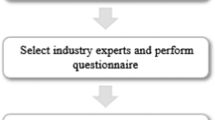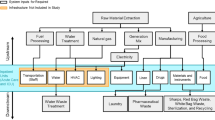Abstract
The petrochemical industry is one of the most important economic resources and producers of materials needed by other industries on a global and regional scale. Although the petrochemical industry has many advantages, it is the source of hazards and adverse effects in various environmental sectors. This paper aims to evaluate the environmental risks of the ammonia and urea production process. For this purpose, the air quality, noise, and water quality parameters were investigated. Then the environmental aspects of the ammonia and urea units were identified through the field visit, review of documentation, and interview with the project technical experts using the Delphi Questionnaire. The environmental aspects were assessed using the Environmental Failure Mode and Effects Analysis (EFMEA) method. Next, the Bow-tie method was used to analyze the cause of occurrence and risk management. Analysis and assessing the aspects indicated that the highest frequency of pollution is related to air pollution (35%) and water pollution (29%). Among the 24 environmental aspects, the highest risk priority number of 100 was related to CO2 emission from the disposal tower. The second priority was the emission of combustible pollutant gases into the environment. Using the Bow-tie method in risk management identifies the main event and shows the causes and consequences of an accident in an understandable way. Therefore, the combined approach of Bow-tie and EFMEA is an appropriate method for risk assessment in the petrochemical industry.




Similar content being viewed by others
Data availability
Data will be made available upon reasonable request.
References
Aust J, Pons D (2020) A systematic methodology for developing Bow-tie in risk assessment: application to borescope inspection. Aerospace 7(7):86. https://doi.org/10.3390/aerospace7070086
Chen QQ, Jia Q, Yuan Z, Huang L (2013) Environmental risk source management system for the petrochemical industry. J Process Saf Environ Prot 92(3):251–260. https://doi.org/10.1016/j.psep.2013.01.004
Cheraghi M, Karbassi A, Monavari SM, Baghvand A (2018) Environmental risk management associated with the development one of oil fields in southwestern Iran using AHP and FMEA methods. J Anthropog Pollut 2(2):41–54. https://doi.org/10.22034/AP.2018.573557.1025
Darvishi S, Jozi SA, Malmasi S, Rezaian S (2020) Environmental risk assessment of dams at constructional phase using VIKOR and EFMEA methods (case study: Balarood Dam, Iran). Hum Ecol Risk Assess Int J 26(4):1087–1107. https://doi.org/10.1080/10807039.2018.1558396
Dunham RB (1998) The Delphi Technique. University of Wisconsin School of Business. http://instruction.bus.wisc.edu/obdemo/readings/delphi.htm
Ghaedsharaf Z, Jabbari M (2020) Identifying hazards and presenting HSE risk management program using Bow-tie and SOWT-ANP methods at the urea unit of Shiraz petrochemical complex. J Saf Health Work 10(1):18–22
Gharibi V, Ghaedi Jahromi M, Mohammadnia MR, Hosseini Gharbi SM (2020) Environmental risk assessment of gas wells drilling effluents: integration of environmental failure mode and effects analysis and analytic network process models. J Health Sci 8(1):49–56
Heller S (2006) Managing industrial risk having a tasted and proven system to prevent and assess risk hazardous material. J Hazard Mater 130(1–2):58–63. https://doi.org/10.1016/j.jhazmat.2005.07.067
Huang RH, Yang CH, Kao CS (2012) Assessment model for equipment risk management: petrochemical industry cases. J Saf Sci 50(4):1056–1066. https://doi.org/10.1016/j.ssci.2010.02.024
Hyett D (2010) Environmental risk assessment in environmental impact assessment–optional or mandatory? IAIA10 Conference Proceedings the Role of Impact Assessment in Transitioning to the Green Economy 30th Annual Meeting of the International Association for Impact Assessment 6–11 April 2010. International Conference Centre Geneva–Switzerland
Jafari MJ, Pouyakian M, Khanteymoori A, Hanifi SM (2021) Development of a framework for dynamic risk assessment of environmental impacts in chemicals warehouse using CFD-BN. Int J Environ Sci Technol 18:3189–3204. https://doi.org/10.1007/s13762-020-03040-0
Johari Z, Cheraghi M, Sobhan Ardakani S (2019) Environmental risk assessment of ilam petrochemical company using analytical network analysis and the technique for order of preference by similarity to ideal solution methods in 2016. J Ilam Univ Med Sci 26(5):79–88. https://doi.org/10.29252/sjimu.26.5.79
Jones FV, Israni K (2012) Environmental risk assessment utilizing Bow-tie methodology. International Conference on Health, Safety and Environment in Oil and Gas Exploration and Production, Perth, Australia. Paper Number: SPE-156833-MS. https://doi.org/10.2118/156833-MS
Jozi SA, Ebadzadeh F (2014) Application of multi-criteria decision-making in land evaluation of agricultural land use. J Indian Soc Remote Sens 42:363–371. https://doi.org/10.1007/s12524-013-0318-8
Kania A, Roszak M, Spilka M (2014) Evaluation of FMEA methods used in the environmental management. J Arch Mater Sci Eng 65(1):37–44
Khodadadi-Karimvand M, Shirouyehzad H (2021) Well drilling fuzzy risk assessment using fuzzy FMEA and fuzzy TOPSIS. JFEA 2(2):144–155. https://doi.org/10.22105/jfea.2021.275955.1086
Khosravirad F, Zarei E, Mohammadfam I, Shoja E (2014) Analysis of root causes of major process accident in town border stations (TBS) using functional hazard analysis (FuHA) and Bow-tie methods. J Occup Hyg Eng 1(3):19–28
Maniram Kumar A, Rajakarunakaran S, Pitchipoo P, Vimalesan R (2018) Fuzzy based risk prioritization in an auto LPG dispensing station. J Saf Sci 101:231–247. https://doi.org/10.1016/j.ssci.2017.09.011
Morris P, Therivel R (2009) Methods of environmental impact assessment. Natural and built environment series, 3rd edn. Routledge, London
Mulcahy MB, Boylan C, Sigmann S, Stuart R (2017) Using Bow-tie methodology to support laboratory hazard identification, risk management, and incident analysis. J Chem Health Saf 24(3):14–20. https://doi.org/10.1016/j.jchas.2016.10.003
Muniz M, Alves Lima G, Caiado R, Quelhas O (2017) Bow tie to improve risk management of natural gas pipelines. J Process Saf Prog 37(2):169–175
Roszak M, Spilka M, Kania A (2015) Environmental failure mode and effects analysis (FMEA)–a new approach to methodology. Metalurgija 54(2):449–451
Saisandhiya NR, VijayBabu K (2020) Hazard identification and risk assessment in petrochemical industry. IJRASET 8:1–12. https://doi.org/10.22214/ijraset.2020.31583
Schmitz P, Swuste P, Reniers G, van Nunen K (2020) Mechanical integrity of process installations: barrier alarm management based on Bow-ties Process. Saf Environ Prot 138:139–147. https://doi.org/10.1016/j.psep.2020.03.009
Schmitz P, Reniers G, Swuste P (2021) Determining a realistic ranking of the most dangerous process equipment of the ammonia production process: a practical approach. J Loss Prev Process Ind. https://doi.org/10.1016/j.jlp.2021.104395
Suter GW, Barnthouse LW, O’Neill RV (1987) Treatment of risk in environmental impact assessment. J Environ Manag 11(3):295–303. https://doi.org/10.1007/BF01867157
Tang Y, Jing J, Zhang Z, Yang Y (2018) A quantitative risk analysis method for the high hazard mechanical system in petroleum and petrochemical industry. Energies 11:14–32. https://doi.org/10.3390/en11010014
Tenney A, Kværner J, Gjerstad KI (2006) Uncertainty in environmental impact assessment predictions: the need for better communication and more transparency. Impact Assess Proj Apprais 24(1):45–56. https://doi.org/10.3152/147154606781765345
Wood C, Dipper B, Jones C (2000) Auditing the assessment of the environmental impacts of planning projects. J Environ Plan Manag 43(1):23–47. https://doi.org/10.1080/09640560010757
Zelenakova M, Zvijakova L, Peptenatu D, Pintilii R-D (2017) Risk analysis with in environmental impact assessment- a review. 17th International Multi-Disciplinary Scientific Geo Conference SGEM, 17: 835–844. https://doi.org/10.5593/sgem2017/51/S20.109
Acknowledgements
The authors are thankful to the anonymous reviewers whose comments and suggestions have greatly helped to improve the article’s quality.
Funding
The authors declare that no funds, grants, or other support were received during the preparation of this manuscript.
Author information
Authors and Affiliations
Contributions
All authors contributed to the study’s conception and design. Material preparation, data collection and analysis were performed by FE, SMM, and SAJ. The first draft of the manuscript was written by FE and Investigation, Validation and reviewed by MR and RR.
Corresponding author
Ethics declarations
Conflict of interest
The authors have no competing interests to declare that are relevant to the content of this article.
Ethical approval
This article does not contain any studies with human participants or animals performed by any of the authors.
Additional information
Editorial responsibility: Samareh Mirkia.
Rights and permissions
Springer Nature or its licensor (e.g. a society or other partner) holds exclusive rights to this article under a publishing agreement with the author(s) or other rightsholder(s); author self-archiving of the accepted manuscript version of this article is solely governed by the terms of such publishing agreement and applicable law.
About this article
Cite this article
Ebadzadeh, F., Monavari, S.M., Jozi, S.A. et al. Combining the Bow-tie model and EFMEA method for environmental risk assessment in the petrochemical industry. Int. J. Environ. Sci. Technol. 20, 1357–1368 (2023). https://doi.org/10.1007/s13762-022-04690-y
Received:
Revised:
Accepted:
Published:
Issue Date:
DOI: https://doi.org/10.1007/s13762-022-04690-y




